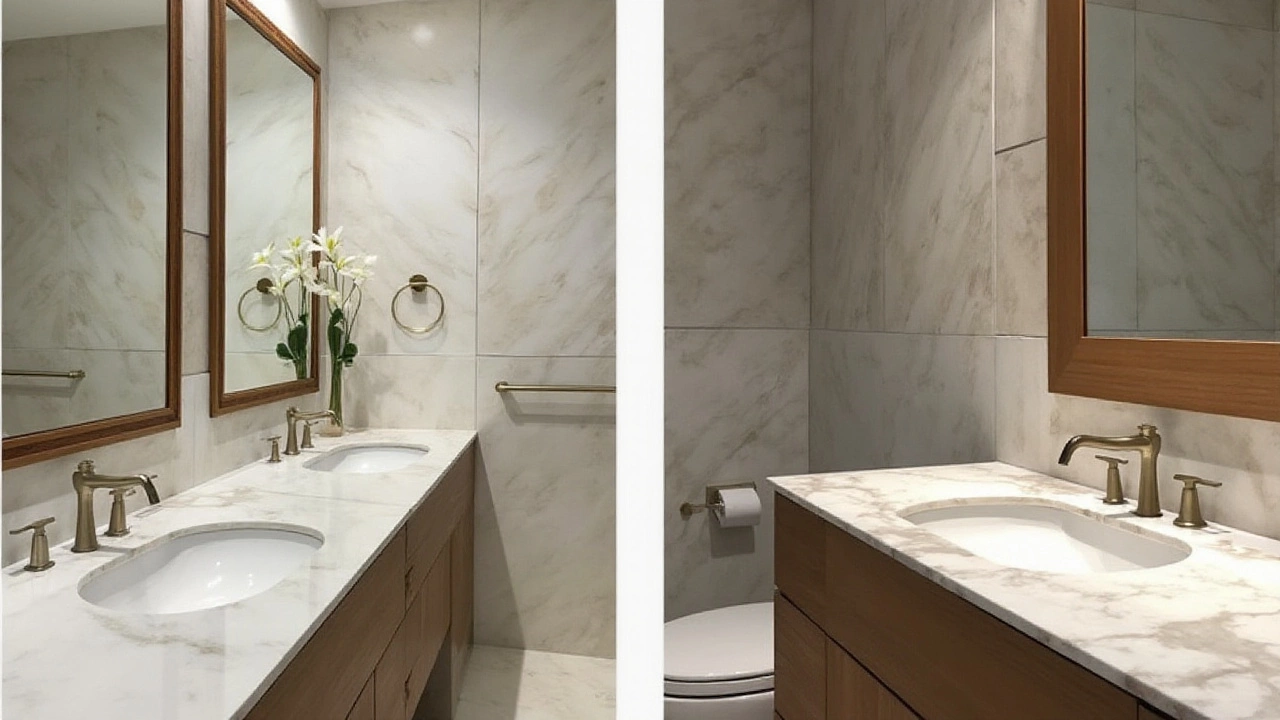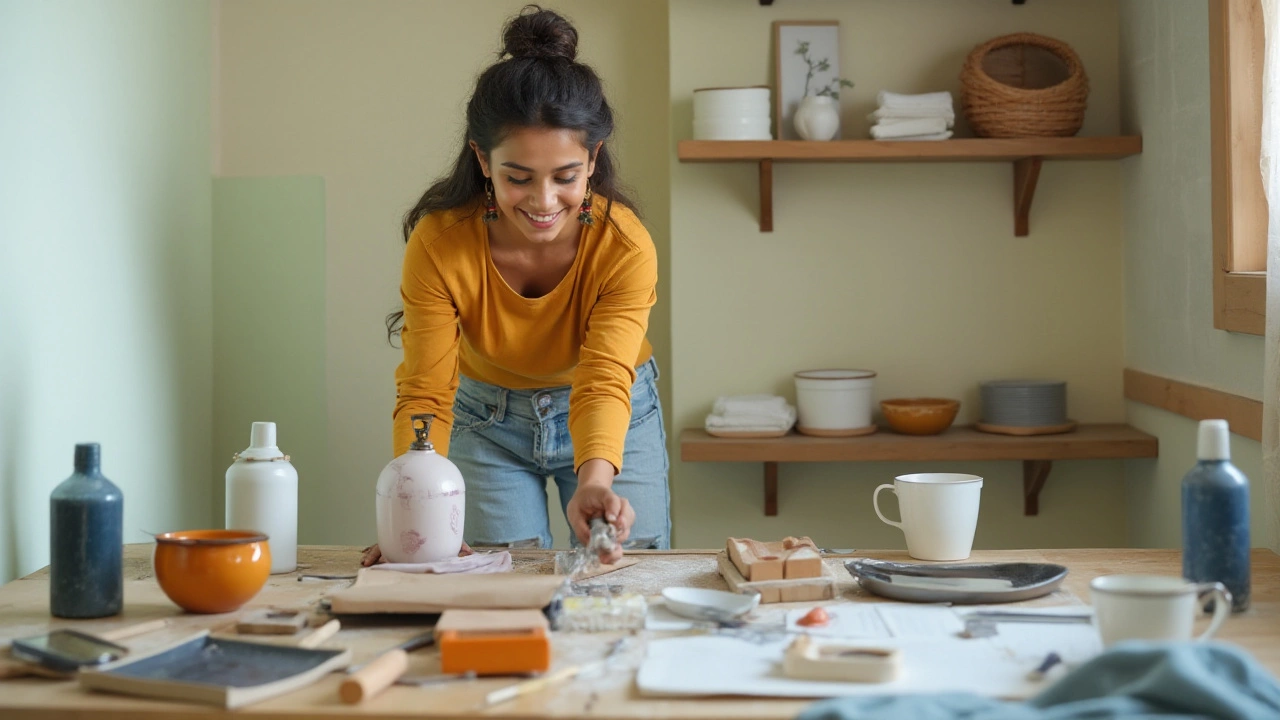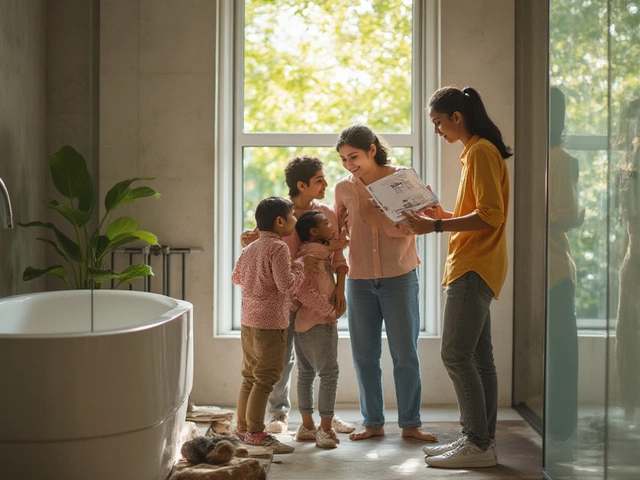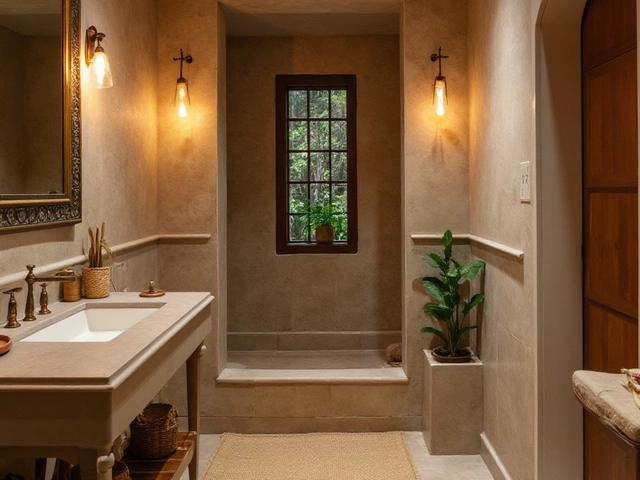Embarking on a bathroom renovation journey might seem like diving into a whirlwind of expenses, but it doesn't have to break the bank. By approaching the project with a clear strategy, you can transform your space without sacrificing your savings.
Whether it’s finding low-cost alternatives for high-end materials or strategically deciding when to enlist professional help, smart choices can go a long way in stretching your renovation budget. With just a bit of creativity, it's possible to achieve a stunning and functional bathroom that doesn't cost a fortune.
- Planning and Budgeting
- Selecting Affordable Materials
- DIY vs. Professional Help
- Smart Upgrades and Alternatives
- Efficient Space Utilization
- Saving on Fixtures and Accessories
Planning and Budgeting
Embarking on a bathroom renovation calls for meticulous planning and careful budgeting to stay on track financially while achieving the aesthetic and functional goals you've set. Your first step is understanding precisely what you want to accomplish in the renovation and distinguishing between needs and luxury desires. This requires a detailed assessment of your current bathroom layout and identifying areas that truly require attention.
Drafting a budget serves as a roadmap, preventing impulse purchases that can wreak havoc on your finances. Experts advise allocating around 20% of your renovation budget for unexpected costs, a tactic that often saves homeowners from financial strain. According to the National Kitchen and Bath Association, the average bathroom remodel in 2023 costs approximately $11,000, but costs can climb or fall based on several factors such as the room’s size, the quality of fixtures, and the extent of remodeling.
"The two biggest repercussions of not planning a renovation well are time delays and unexpected expenditures," advises remodel consultant Susan Albright, whose clients frequently lament skimping on the planning phase.
A successful plan outlines your spatial limitations, acknowledges any plumbing or electrical constraints, and indicates style preferences. For those with less experience, investing in a consultation with a design professional at the onset can provide valuable insights, saving you money in the long run by avoiding costly mistakes. To keep spending in check, prioritize your spending — dedicating more budget toward quality essentials like waterproofing and flooring while opting for cost-effective alternatives for cosmetic changes.
Utilizing a prioritized list helps track progress and expenses. Consider key elements such as labor, which consumes nearly 40% to 65% of your budget depending on your DIY vs. professional help approach. For instance, if you demolish old tiles but hire a professional to install the new ones, you might save on labor fees. Allocate funds wisely across other essentials like plumbing and electricity, which are critical to a bathroom's core functionality.
Effective budget planning translates into strategically dividing your project into phases and setting a schedule that allows for leisurely shopping around for fixtures and materials. Keep an eye out for sales or discounts at your local stores or online marketplaces. In some cases, recycled or gently used appliances not only cut costs but add character to your refurbishing efforts, exemplifying both the thriftiness and aesthetic appeal.
Setting a Realistic Timeline
Embrace a flexible timeline that accounts for material delivery times and contractor availability. Rushing through decisions to meet a tight schedule often backfires in the quality of the outcome, leading to dissatisfaction and potential redo expenses. A good rule of thumb is to expect the project to take longer than anticipated; remodelling requires patience and adaptability. Keep communication open with any hired help to remain actively involved in every phase of the renovation, ensuring that the end result mirrors your initial vision.
Selecting Affordable Materials
Let’s face it: the right materials are the backbone of any successful renovation, but choosing affordable materials doesn’t mean sacrificing quality. The key lies in clever sourcing and knowing exactly where to look for these budget-friendly options. First off, explore the vast world of alternatives. For instance, if the charm of natural stone captivates you, consider opting for porcelain tiles that mimic stone finishes. This can drastically cut costs while still giving your bathroom that luxe feel you're aiming for. Many manufacturers have perfected these alternatives, making them virtually indistinguishable from the real thing.
Next up, scour those sales. Retailers frequently offer discounts on tiles and fixtures to make room for new inventory, so keep an eye out for sales and clearance sections. Seasoned renovators know that timing can be everything. Around major holidays or at the end of the year, discounts often peak. If you’re willing to be patient, the savings can be significant.
Don't shy away from exploring wholesale markets and online marketplaces either. By buying materials in bulk or sourcing from websites like Craigslist, you might just stumble upon rare finds or excess materials from someone else's project. Another winning strategy: consider recycled or reclaimed materials. They're not only eco-friendly but also often more affordable. Find fixtures or vanities that have stood the test of time and give them a fresh lease on life with a coat of paint or finish.
"There is beauty in repurposing. It’s about giving something a new story and purpose," says home renovation expert Joanna Gaines. This philosophy can guide you towards unique, personalized touches that aren’t available at every store.
When it comes to counters and tops, solid surface materials offer a versatile, cost-effective solution. Alternatively, laminate countertops have come a long way in terms of aesthetics and durability. They now emulate high-end finishes beautifully without hitting your wallet hard.
Determining Durability
Budget-friendly remodel does not mean cutting corners on durability. Ensure that whatever you choose will withstand the humid conditions of a bathroom. Varieties like vinyl flooring boast being both water-resistant and budget-conscious. You’d be surprised how vinyl, with its myriad styles, can replicate much of the look you want for less.
Lastly, consider the potential of unfinished materials. Unfinished cabinets, for example, don’t carry the premium of their pre-painted siblings and give you the freedom to express your style. Plus, they allow for more natural wear and tear repair, making them a practical option in the long run for a budget-friendly bathroom renovation.
| Material | Cost Range (per sq ft) | Alternative Suggestion |
|---|---|---|
| Natural Stone Tile | $10 - $30 | Porcelain Tile |
| Wood Flooring | $8 - $20 | Vinyl Flooring |
| Granite Countertops | $40 - $60 | Laminate Countertops |

DIY vs. Professional Help
Tackling a bathroom renovation often prompts the age-old dilemma: should you go DIY or hire a professional? This decision isn't simply about cost, but rather it revolves around your skill level, timeline, and the complexity of your project. Opting for a DIY approach can undoubtedly save you money, as long as you're comfortable with tools and possess a foundational understanding of renovation basics. Plumbing and electrical tasks might seem daunting at first, but many resources are available to guide you through the processes step-by-step.
In some cases, the prospect of handling significant aspects of a project might be overwhelming. There's no shame in opting for professional help. Professionals bring years of experience to the table, which can result in a faster and often more beautiful outcome. For complex plumbing installations or intricate tiling work, hiring someone with expertise can mitigate risks and ensure a long-lasting and high-quality finish.
To weigh your options effectively, consider the specifics of what your remodel entails. If your updates are cosmetic, like painting, changing accessories, or installing new light fixtures, these can typically be managed by any enthusiastic DIYer. However, when major structural changes are involved, professional consultation might be necessary. It's estimated that hiring professionals for the entire project can add as much as 20% to your budget, yet ensures peace of mind and frees you from potential mishaps. According to a 2023 survey by Remodeling Magazine, homeowners who partnered with professionals reported an increased satisfaction rate by 25% compared to those who went solo.
Think deeply about how much time can be devoted to the renovation. DIY projects usually stretch longer than anticipated, especially when balancing work and personal commitments. On the other hand, professionals may propose a quicker timeline, but it's crucial to vet their experience to avoid costly mistakes. Financial consideration also plays a significant role, so evaluate the different costs—materials, potential tool rentals, and labor—before making a decision. A simple task like replacing a sink fixture might seem straightforward, but an incorrect installation can lead to water damage down the line.
For those with a bit of grit and enthusiasm, a hybrid approach might be the perfect balance. Consider hiring professionals for the core workmanship while handling the straightforward aspects yourself. Not only does this allow for some cost savings, but it also offers a sense of accomplishment as you contribute your touch to your bathroom's transformation. When you find the right mix between professional help and self-reliance, your bathroom renovation becomes both a financially savvy and personally rewarding project.
Smart Upgrades and Alternatives
When venturing into the world of bathroom renovation, making smart upgrades can redefine your space both functionally and aesthetically without hemorrhaging your finances. Fixtures, for example, are often the centerpiece of a bathroom’s charm, and upgrading them can provide a fresh, modern look. Opting for energy-efficient showerheads and faucets will not only reduce water bills over time but also offer a contemporary edge. On another note, consider refurbishing cabinets rather than investing in new ones. A fresh coat of paint or new handles can revitalize old surfaces, providing an unexpectedly chic appearance.
Delving deeper, lighting plays a pivotal role in shaping the ambiance. Swapping outdated fixtures for LED lights creates a warm, inviting atmosphere while simultaneously being gentle on your utility expenses. Many find beauty in simplicity, and open shelving is a trend that marries aesthetics with functionality. It requires minimal investment but holds the power to open up small spaces, making rooms feel larger and more breathable.
Rather than replacing old tiles completely, look at alternatives like painting or re-grouting them. Both options are affordable yet immensely effective in refreshing a bathroom. It's fascinating how a splash of color can revive any area, and color blocking with tiles is a creative and cost-efficient strategy that can yield a stunning visual effect.
"In bathroom renovations, where you invest matters just as much as how much you invest. Little, impactful changes can stretch a modest budget far," insists Linda Ramos, renowned interior designer and editor at Stylish Home Ideas.
Let's not forget the mirror's ability to elevate designs; changing to a modern, perhaps larger mirror can amplify elegance and add depth. Mirrors that feature storage functionalities offer a blend of practicality and style, optimizing the available space smartly. And speaking of storage, baskets and decorative boxes are great allies in maintaining organization while adding a touch of warmth to the decor.
Ultimately, smart upgrades are not about cutting corners but rather making informed decisions that achieve a harmonious, stylish, and budget-friendly remodel. By assessing the room dynamics and prioritizing changes with the maximum impact, you can transform your bathroom into a sanctuary without costly overhauls. This thoughtful approach ensures satisfaction in both aesthetics and finance, proving that luxury is indeed attainable on a budget. With creativity as your compass, the possibilities are truly endless.

Efficient Space Utilization
When it comes to maximizing a bathroom's potential, efficient space utilization isn't just a buzzword—it's a necessity. Often, bathrooms are the smallest rooms in a home, so every inch counts significantly. An intelligent design approach can fundamentally transform a cramped space into a sanctuary of functionality and style. Begin by assessing your current layout and envision where improvements can be made. Consider the space behind doors, corners, and even hidden vertical stretches, as these often-overlooked areas can offer storage solutions. Storage is more than just a shelf for towels; it's about making your bathroom renovation a comprehensive solution to clutter while keeping future needs in scope.
To optimize storage, it's effective to use vertical spaces creatively. Wall-mounted cabinets or shelves that extend up toward the ceiling make the most of the room’s height. Such solutions not only free up floor space but also keep the bathroom's footprint open and more breathable. DIY bathroom projects like creating bespoke shelves from reclaimed wood can bring warmth and character, providing both functionality and charm. Similarly, recessed shower niches are practical for storing bath products within reach while maintaining a sleek appearance. Investing in multifunctional furniture, such as a storage ladder or a vanity with built-in compartments, allows you to double down on utility without overwhelming the space.
The efficient layout of fixtures is another key aspect. Rotating the position of certain elements can greatly affect the sense of space. Placing the toilet in a niche or corner and opting for a walk-in shower rather than a bulky bathtub can open up a congested room significantly. Another clever technique is to use a wall-mounted sink with exposed plumbing for an industrial look that suits modern aesthetics while freeing up lower space. You could even think about smart upgrades like installing pocket doors instead of traditional swinging doors to save precious space.
Lighting is an unsung hero in space optimization. Effective lighting design can make even the smallest bathroom feel larger by creating the illusion of height or depth. Recessed lighting along the edges of the ceiling or under-cabinet LEDs for vanities can ensure the space remains bright and welcoming. Mirrors, a traditional trick, play a dual role in both lighting and expansion, reflecting light and visually elongating the room. A well-placed large mirror adjacent to or above the sink can create an impressive effect, making the area appear airy and spacious.
Embrace the power of decor accessories that serve dual purposes—hooks for robes and towels can be stylish yet unobtrusive. Consider the materials, too; choosing lighter colors and reflective surfaces can help amplify natural light, imbuing the room with a more substantial, airy atmosphere. Using a small, tasteful selection of accessories means keeping countertops clear, helping visually expand the space. These minor adjustments can lend a luxurious touch without demanding constant upkeep or significant financial investment.
"Good design is making something intelligible and memorable. Great design is making something memorable and meaningful." — Dieter Rams
In concluding these practices, crafting a well-thought-out design is not merely about adding or subtracting elements. It's about harmonizing form and function to yield a budget-friendly remodel that feels both expansive and efficient. Every small change contributes to a greater whole, prizing ingenuity and comfort above merely fitting into a small space. Imprint your personality on these walls, knowing that efficient space utilization is not just an exercise in economy but a celebration of thoughtful design.
Saving on Fixtures and Accessories
When it comes to a bathroom renovation, fixtures and accessories often occupy a significant chunk of the budget. Yet, with a bit of ingenuity and a discerning eye, you can refresh these elements without overspending. Start by considering the transformative power of replacing old fixtures. You don’t need to splurge on top-of-the-line pieces; instead, explore retailers that offer discounted or clearance pricing on quality items. Seconds, ex-display, or last season’s stock can often be picked up for a fraction of their original price, allowing you to achieve a sleek look at a reduced cost.
Focus on timeless designs and neutral colors for fixtures as these choices promise longevity and versatility, seamlessly integrating with future style changes. For eco-conscious homeowners, opting for fixtures with water-saving features can offer dual benefits of reducing utility bills while contributing positively to the environment. Water-efficient toilets, faucets, and showerheads can offer substantial savings over time.
When accessorizing, take a 'less is more' approach. Minimalist accessories add elegance without cluttering the space. Items like towel racks, soap dishes, and mirrors can be inexpensive but high-impact additions. Repurposing materials can also be a clever method to save costs; for instance, an old ladder can serve as an avant-garde towel holder, offering a rustic charm while performing a practical function. Antique shops, flea markets, or even digital marketplaces can be treasure troves where unique but affordable accessories await.
"The magic of a well-done bathroom isn't in the money spent but in the thoughtful detail," says renowned interior designer Nate Berkus. "Choose pieces that reflect your style, and you'll create a space that's both comfortable and timeless."
Lighting, too, plays a significant role in the bathroom's ambiance but doesn’t need to drain resources. Swap outdated light fittings for contemporary LED options which not only modernize the bathroom but also support energy efficiency. The ability to dim lights can moreover transform the bathroom into a spa-like retreat at the flick of a switch. Dimmers are an inexpensive addition that offers adaptability to any setting.
Lastly, consider the finish. Coordinating fixtures and fittings in the same finish can bring coherence but doesn't have to mean buying new. Spray paints designed for metal can refresh tired hardware, giving them a chic, cohesive look for just a few dollars. Indeed, when you're on the hunt for a budget-friendly remodel, every choice should balance both aesthetic appeal and financial sense, proving that stylish bathrooms can be achieved without deep pockets or grand budgets.



Write a comment